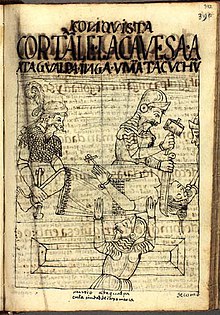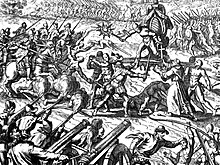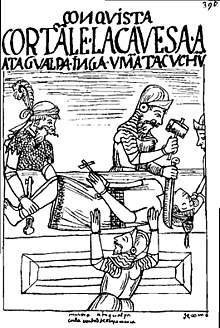Atahualpa
According to de Velasco, the Kingdom of Quito was made up of the Shyris or Scyris ethnic group and disappeared when it was conquered by the Incas.Several historians, such as the Peruvian Raúl Porras Barrenechea and the Ecuadorian Jacinto Jijón y Caamaño, have rejected this version for lack of historical and archaeological foundation.Most Peruvian historians maintain that, according to the most reliable chronicles (Cieza, Sarmiento and Betanzos, who took their reports firsthand), Atahualpa was born in Cusco and his mother was a princess of Inca lineage.These historians consider that Huáscar's side invented the version of Atahualpa's Quito origin to show him to the Spanish as a usurper and bastard.Around 1460, Tupac Inca Yupanqui, with an army of 200,000 warriors that were sent by his father, easily gained control of the Palta nation in southern Ecuador and northern Peru in a matter of months.After defeating them in the battle of Atuntaqui, Tupac Yupanqui sent settlers to what is now the city of Quito and left as governor Chalco Mayta, belonging to the Inca nobility.He personally led his army and defeated the rebels in the battle of Laguna de Yahuarcocha where there was such a massacre that the lake turned to blood.[19] A tense five-year peace ensued, Huáscar took advantage of that time to get the support of the Cañari, a powerful ethnic group that dominated extensive territories of the north of the empire and maintained grudges against Atahualpa, who had fought them during his father's campaigns.While based in Marcahuamachuco, he sent an emissary to consult the oracle of the Huaca (god) Catequil, who prophesied that Atahualpa's advance would end poorly.[25] In January 1531, a Spanish expedition led by Francisco Pizarro, on a mission to conquer the Inca Empire, landed on Puná Island.[26][page needed] The Spaniards headed south and occupied Tumbes, where they heard about the civil war that Huáscar and Atahualpa were waging against each other.[27] About a year and a half later, in September 1532, after reinforcements had arrived from Spain, Pizarro founded the city of San Miguel de Piura and then marched towards the heart of the Inca Empire with a force of 106 foot-soldiers and 62 horsemen.The Spaniards were billeted in certain long buildings on the main square and Pizarro sent an embassy to the Inca, led by Hernando de Soto.[35] The plan was to persuade Atahualpa to submit to the authority of the Spaniards and, if this failed, there were two options: a surprise attack, if success seemed possible or to keep up a friendly stance if the Inca forces appeared too powerful.[36] The following day, Atahualpa left his camp at midday, preceded by a large number of men in ceremonial attire; as the procession advanced slowly, Pizarro sent his brother Hernando to invite the Inca to enter Cajamarca before nightfall.[41] According to eyewitness accounts, Valverde spoke about the Catholic religion but did not deliver the requerimiento, a speech requiring the listener to submit to the authority of the Spanish Crown and accept the Christian faith.[43] At that moment, Pizarro gave the signal; the Spanish infantry and cavalry came out of their hiding places and charged the unsuspecting Inca retinue, killing a great number while the rest fled in panic.[47] After several months in fear of an imminent attack from general Rumiñawi, the outnumbered Spanish considered Atahualpa to be too much of a liability and decided to execute him.Pizarro staged a mock trial and found Atahualpa guilty of revolting against the Spanish, practicing idolatry and murdering Huáscar, his brother.A myth concerning Atahualpa's death and future resurrection became widespread among indigenous groups, with versions of the tale being documented as far as among the Huilliche people of southern Chile.[53] A rare version recorded by Tom Dillehay among the Mapuche of Araucanía tells of Atahualpa killing Pedro de Valdivia.Atahualpa Inca's conflict with Pizarro was dramatized by Peter Shaffer in his play The Royal Hunt of the Sun, first staged by the National Theatre in 1964 at the Chichester Festival, then in London at the Old Vic.The role of Atahualpa was played by Robert Stephens and by David Carradine, who received a Theatre World Award in the 1965 Broadway production.Atahaulpa plays a key role in Laurent Binet's 2019 alternate history novel Civilizations, journeying across the Atlantic and going on to conquer much of Europe.










Atawallpa (Cusco)Bolivian provinceAtahuallpa ProvinceAtahualpa (ship)Cuzco SchoolEthnological Museum of BerlinGermanySapa IncaInca EmpireinstallationHuáscarTúpac HuallpapuppetCajamarcaCoya AsarpayCuxirimay OclloQuechuaDynastyHuayna CápacPaccha DuchicelaInca emperorexecutionSpanish conquest of the Inca EmpireNinan CuyochismallpoxInca Civil WarconquistadorsFrancisco Pizarroan ambush at CajamarcagarrotedchickenetymologicalBlas Valeraperson namePuquinaPedro Cieza de LeónCaranquiJuan de BetanzosñustaPachacutiJuan de VelascoMarcos de NizaKingdom of QuitoShyrisKurakaPacchaRaúl Porras BarrenecheaJacinto Jijón y CaamañochroniclerGuaman PomaTopa YupanquiVilcashuamánHuayna CapacTomebambaFrancisco López de GómaraPedro Sarmiento de GamboaInca Garcilaso de la VegaFelipe Guamán Poma de AyalaChachapoya cultureJuan de Santa Cruz PachacutiBernabé CoboAgustín de ZárateMiguel Cabello de BalboaWarachikuyCaranquisInca armyChalcuchímacQuizquizBrooklyn MuseumTupac Inca YupanquiCañariQuitusAtuntaquiPuruháYahuarcochaPedro PizarroTumebambaChasquiTumbesbattle of ChillopampaTheodor de BryBibliothèque nationale de FranceMarcahuamachucoCatequilPizarroRumiñawiMullihambatoChimborazoBattle of QuipaipánBattle of CajamarcaPuná IslandSan Miguel de Piurahot springsacllasHernando de SotoHernando Pizarrolitterhammocksbattle axesslingsDominican friarVincente de ValverdePizarro Seizing the Inca of PeruJohn Everett MillaisrequerimientoSpanish CrownChristianbreviarysilveremeraldsa large roomFuneral of AtahualpaLuis Montero CáceresidolatryCatholicismIbarraEcuadorstranglinggarroteManco IncaRoyal Palace of MadridInés YupanquiDominicanJosé Desiderio ValverdeBolivianPedro José Domingo de Guerra
